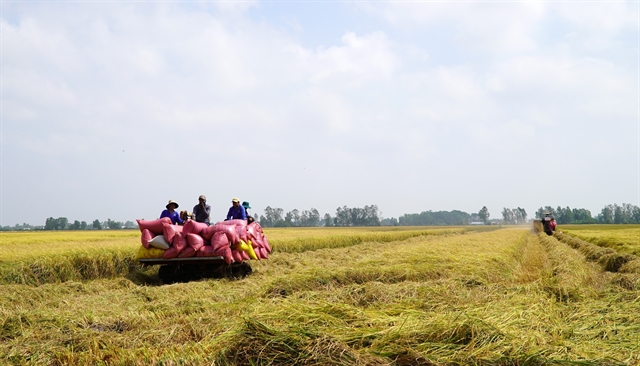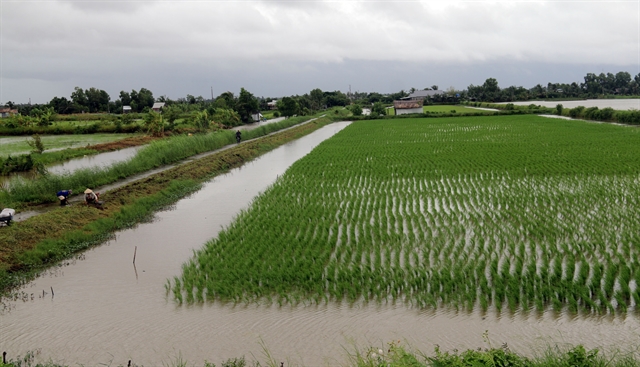Kiên Giang Province to comfortably exceed rice production target
Society – Economy - Ngày đăng : 06:24, 15/11/2024
 |
| Farmers in Kiên Giang Province’s Tân Hiệp District harvest summer- autumn rice earlier this year. – VNA/VNS Photo Văn Sĩ |
KIÊN GIANG – Kiên Giang Province is expected to harvest over 4.6 million tonnes of paddy this year, 200,000 tonnes higher than its target.
Việt Nam’s largest rice-producing province grows 725,210ha of rice this year, with 93.5 per cent devoted to high-quality varieties, according to the provincial Department of Agriculture and Rural Development.
Situated in the (Cửu Long) Mekong Delta, the province grows three rice crops annually, with the winter-spring one being the largest at over 352,800ha planted this year.
Lê Hữu Toàn, the department’s director, stated that the department has collaborated with localities to implement the provincial rice-growing plan, forecast pest risks and provided guidance on sowing schedules and farming techniques.
They have also enhanced weather monitoring and hydro-meteorological forecasting to develop plans for addressing drought, saltwater intrusion and flood risks from heavy rains, helping minimise their impacts on agriculture.
The province has promoted advanced farming techniques like “three increases-three reductions” and “one must-five reductions”.
“One must-five reductions” requires using certified seeds and reducing the use of seedlings, nitrogenous fertilisers, plant protection chemicals, and irrigation and post-harvest losses.
Kiên Giang has adopted international rice-growing standards, such as the Sustainable Rice Platform, focusing on enhancing quality, economic efficiency, competitiveness, and environmental and social security protection.
The Irrigation Sub-department effectively operates sluices in sea dykes and embankments, managing irrigation for agriculture. It collaborates with the Southern Irrigation Work Exploitation and Management One Member Ltd. Co to operate the Cái Lớn - Cái Bé and Xẻo Rô irrigation systems, preventing flooding in low-lying areas.
The province is managing 767 large-scale rice fields totalling 116,500ha this year, 405 of which are cultivated under stakeholder linkages.
It has 27,080ha of large-scale fields meeting SRP, organic, VietGAP and GlobalGAP standards, whose output is exported to the EU, US, and Japan.
Besides, it is cultivating 60ha of rice in Tân Hiệp and An Minh districts under the Ministry of Agriculture and Rural Development’s project to sustainably develop one million hectares of high-quality, low-emission rice cultivation aimed at green growth in the Mekong Delta.
Of this, 10ha area are under a rice-shrimp farming model.
 |
| Rice-shrimp fields in Kiên Giang Province’s An Minh District. – VNA/VNS Photo Lê Sen |
Rice-shrimp farming
Kiên Giang has approximately 107,000ha of rice-shrimp farming, where farmers grow rice during the rainy season and breed shrimp during the dry season.
The province encourages coastal farmers affected by dry-season saltwater intrusion to adopt this model as it reduces production costs and increases yields and profits.
Nguyễn Văn Hải of An Minh District’s Đông Hoà Commune farms one rice crop and two shrimp crops annually on his three-hectare field, earning an income around VNĐ200 million (US$7,900).
His rice meets VietGAP standards and so fetches a VNĐ200 per kilogramme premium from traders, he said.
“I use minimal fertilisers and pesticides, reducing production costs to less than VNĐ20 million ($790) per hectare, which boosts profits by 1.5 times compared to traditional methods.”
Many rice-shrimp farmers have joined co-operatives and co-operative groups to lower production costs and enhance efficiency.
Võ Văn No of An Minh’s Đông Hưng B Commune joined the Ngã Bát Agricultural Service Co-operative and is guaranteed rice sales.
In this current crop he is cultivating ST24 and ST25, two of the world’s best rice varieties, on 3.5ha.
“Agricultural officials have provided guidance on VietGAP-standard rice growing to ensure high quality for export,” he said.
Farmers in An Minh District are growing 27,000ha of rice in rice-shrimp fields, with 70 per cent sown with high-quality varieties, according to the district’s Bureau of Agriculture and Rural Development.
Nguyễn Thanh Điền, the bureau’s deputy head, said that since 2022 the district has been strengthening value chains for rice-shrimp farming by encouraging companies to sign contracts with co-operatives.
Around 1,000ha of organic rice and 2,000ha of rice-shrimp fields operate under farming contracts, he added.
Rice-shrimp farming improves soil fertility and helps manage disease pathogens.
After the shrimp season ends, the crustaceans’ waste fertilises rice plants, reducing fertiliser and pesticide use.
After the rice season straw and fallen seeds decompose, they provide natural foods for the shrimp.
The province aims to expand rice-shrimp farming to 117,340ha by 2030.
To achieve this, it has advised farmers to convert unproductive mono-rice fields affected by saltwater intrusion into rice-shrimp fields.
This switch increases annual profits to VNĐ100-130 million ($4,000-5,200) per hectare, compared to VNĐ50 million ($2,000) from mono-rice fields, stated the Department of Agriculture and Rural Development.
Toàn, the department’s director, said the province would focus on enhancing rice and shrimp yields through advanced techniques and foster collaboration among stakeholders to sustainably develop rice-shrimp farming.
It plans to establish more co-operatives and co-operative groups linked with companies to develop value chains for major rice-shrimp areas.
Brand names and geographical indications have been developed for rice and shrimp products, boosting export values and farmers’ profits, Toàn added. – VNS
